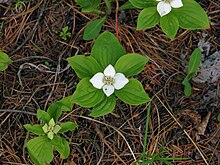| Cornus Temporal range: Late Campanian–Holocene,
| |
|---|---|

| |
| Cornus kousa var. chinensis | |
| Scientific classification | |
| Kingdom: | Plantae |
| Clade: | Tracheophytes |
| Clade: | Angiosperms |
| Clade: | Eudicots |
| Clade: | Asterids |
| Order: | Cornales |
| Family: | Cornaceae |
| Genus: | Cornus L. |
| Type species | |
| Cornus mas | |
| Subgenera | |
| |
| Synonyms | |
|
Chamaepericlimenum Hill | |







Cornus is a genus of about 30–60 species[Note 1] of woody plants in the family Cornaceae, commonly known as dogwoods or cornels, which can generally be distinguished by their blossoms, berries, and distinctive bark.[3] Most are deciduous trees or shrubs, but a few species are nearly herbaceous perennial subshrubs, and some species are evergreen. Several species have small heads of inconspicuous flowers surrounded by an involucre of large, typically white petal-like bracts, while others have more open clusters of petal-bearing flowers. The various species of dogwood are native throughout much of temperate and boreal Eurasia and North America, with China, Japan, and the southeastern United States being particularly rich in native species.
Species include the common dogwood Cornus sanguinea of Eurasia, the widely cultivated flowering dogwood (Cornus florida) of eastern North America, the Pacific dogwood Cornus nuttallii of western North America, the Kousa dogwood Cornus kousa of eastern Asia, and two low-growing boreal species, the Canadian and Eurasian dwarf cornels (or bunchberries), Cornus canadensis and Cornus suecica respectively.
Depending on botanical interpretation, the dogwoods are variously divided into one to nine genera or subgenera; a broadly inclusive genus Cornus is accepted here.
- ^ Atkinson, Brian A.; Stockey, Ruth A.; Rothwell, Gar W. (2016). "Cretaceous origin of dogwoods: an anatomically preserved Cornus (Cornaceae) fruit from the Campanian of Vancouver Island". PeerJ. 4: e2808. doi:10.7717/peerj.2808. PMC 5180587. PMID 28028474.
- ^ Qiu-Yun (Jenny) Xiang; David T. Thomas; Wenheng Zhang; Steven R. Manchester & Zack Murrell (2006). "Species level phylogeny of the genus Cornus (Cornaceae) based on molecular and morphological evidence – implications for taxonomy and Tertiary intercontinental migration". Taxon. 55 (1): 9–30. doi:10.2307/25065525. JSTOR 25065525.
- ^ "Notable Characteristics of Dogwood Trees". answers.com. Archived from the original on August 26, 2014. Retrieved August 24, 2014.
Cite error: There are <ref group=Note> tags on this page, but the references will not show without a {{reflist|group=Note}} template (see the help page).